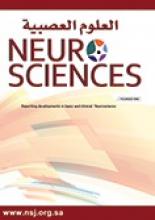Research ArticleOriginal Article
Open Access
Perioperative lumbar drain utilization in transsphenoidal pituitary resection
Shatha Alharbi, Griffith Harsh and Abdulrazag Ajlan
Neurosciences Journal January 2018, 23 (1) 46-51; DOI: https://doi.org/10.17712/nsj.2018.1.20170136
Shatha Alharbi
from the Department of Neurosurgery (Alharbi), King Faisal Specialist Hospital & Research Center, and from the Department of Surgery and Department of Neurosurgery (Ajlan), College of Medicine, King Saud University, and from the Department of Neurosurgery (Harsh, Ajlan), Stanford University, Stanford, California, United States of America
MBBSGriffith Harsh
from the Department of Neurosurgery (Alharbi), King Faisal Specialist Hospital & Research Center, and from the Department of Surgery and Department of Neurosurgery (Ajlan), College of Medicine, King Saud University, and from the Department of Neurosurgery (Harsh, Ajlan), Stanford University, Stanford, California, United States of America
MDAbdulrazag Ajlan
from the Department of Neurosurgery (Alharbi), King Faisal Specialist Hospital & Research Center, and from the Department of Surgery and Department of Neurosurgery (Ajlan), College of Medicine, King Saud University, and from the Department of Neurosurgery (Harsh, Ajlan), Stanford University, Stanford, California, United States of America
FRCS, MSc
References
- ↵
- Fatemi N,
- Dusick JR,
- de Paiva Neto MA,
- Kelly DF
- ↵
- Nishioka H,
- Haraoka J,
- Ikeda Y
- ↵
- Monsalves E,
- Larjani S,
- Loyola Godoy B,
- Juraschka K,
- Carvalho F,
- Kucharczyk W,
- et al.
- ↵
- Rabadán AT,
- Hernández D,
- Ruggeri CS
- ↵
- Jung H,
- Shah A,
- Ajlan A
- ↵
- Mehta GU,
- Oldfield EH
- ↵
- Sade B,
- Mohr G,
- Frenkiel S
- ↵
- Ransom ER,
- Palmer JN,
- Kennedy DW,
- Chiu AG
- ↵
- Hadad G,
- Bassagasteguy L,
- Carrau RL,
- Mataza JC,
- Kassam A,
- Snyderman CH,
- et al.
- ↵
- Stokken J,
- Recinos PF,
- Woodard T,
- Sindwani R
- ↵
- Ivan ME,
- Iorgulescu JB,
- El-Sayed I,
- McDermott MW,
- Parsa AT,
- Pletcher SD,
- et al.
- ↵
- Esposito F,
- Dusick JR,
- Fatemi N,
- Kelly DF
- ↵
- Patel MR,
- Stadler ME,
- Snyderman CH,
- Carrau RL,
- Kassam AB,
- Germanwala AV,
- et al.
- ↵
- Shiley SG,
- Limonadi F,
- Delashaw JB,
- Barnwell SL,
- Andersen PE,
- Hwang PH,
- et al.
- ↵
- Zhan R,
- Chen S,
- Xu S,
- Liu JK,
- Li X
- ↵
- Pepper JP,
- Lin EM,
- Sullivan SE,
- Marentette LJ
In this issue
Perioperative lumbar drain utilization in transsphenoidal pituitary resection
Shatha Alharbi, Griffith Harsh, Abdulrazag Ajlan
Neurosciences Journal Jan 2018, 23 (1) 46-51; DOI: 10.17712/nsj.2018.1.20170136
Jump to section
Related Articles
- No related articles found.
Cited By...
- No citing articles found.





